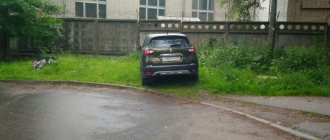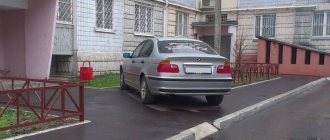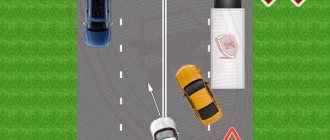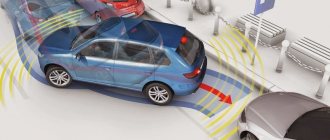Any citizen who gets behind the wheel of a car must comply with the Traffic Rules and other regulations governing the movement of vehicles, as well as their parking.
Parking on the lawn is one of the most controversial violations. Federal law does not establish penalties for this action. The legality of holding a car owner liable is determined based on local laws and regulations.
What is considered a lawn when parking a vehicle?
A lawn is an area of land planted with grass. It serves as an element of landscaping. There are lawns in parks and squares where they are intended for walking. In squares and parks, lawns are not always separated by curbstones. But in these cases they do not have a direct connection with the highway.
Considering the fact that the lawn is not part of the road and is usually separated from it by a curb, parking a car in such a place is a violation of the Traffic Rules, for which a fine is imposed for parking on the lawn.
To be fair, it should be noted that the concept of “lawn” is not in the Code of Administrative Offenses and the Traffic Regulations. Hence many controversial issues regarding fines. However, in regional laws you can find different designations for this territory. Among other things, they contain provisions where the authorities demand payment from the culprit for damage to the lawn.
What is a lawn in Moscow according to the law?
Fines and penalties for parking on the lawn
Since the articles of the traffic rules bypass the degree of punishment for parking on the lawn, the executive authorities, when issuing fines in this case, are guided by local laws on administrative violations.
In Moscow, these actions can be regarded as damage to green spaces through the use of a car and be punished with 4,000 or 4,500 rubles.
Moreover, the fine imposed on an official for the same thing can reach 50,000 rubles, and on a legal entity - 300,000.
In other cities, penalties for parking on a green lawn vary:
- 500 – 2000 rubles (citizens);
- 1000 – 5000 rubles (officials);
- 5,000 – 20,000 rubles (for legal entities).
And in addition, an incorrectly parked car that creates a nuisance to others must be towed.
https://www.youtube.com/watch?v=lrPSJ-jbpSQ
What is the fine for parking on the lawn?
Next, we will consider the amount of administrative punishment in 2021 for individuals, officials and legal entities in federal cities of the Russian Federation, and then in other regions.
Administrative responsibility in Moscow
In Moscow, a regulatory body such as the Traffic Management Center, operating under the city government, can issue a fine.
For such a violation on the basis of Article 8.25 of Moscow Law No. 45 of November 21, 2007:
- an individual will be fined 5,000 rubles;
- officials will have to pay 30,000 rubles;
- and for organizations – 300,000 rubles.
Violation of parking rules in St. Petersburg
In the Northern capital, in accordance with Article 32 of St. Petersburg Law No. 273-70 of May 31, 2010, the following fines are imposed for parking on the lawn:
- for individuals: 3-5 thousand rubles;
- for officials: 5-40 thousand rubles;
- for legal entities: 150-500 thousand rubles.
How much will you have to pay for parking in a green zone in other regions?
In other Russian regions, the amount of fines is determined by local regulations. If there is no such law in the subject, then the norm specified in the Code of Administrative Offenses (Article 12.19 of the Code of Administrative Offenses) is adopted - 500 rubles.
Normative documents
The basis for the possibility of bringing to justice motorists who leave their vehicle in a prohibited area is:
- Law No. 273-70, which is largely applicable to only one region of the Russian Federation and determines the fine for parking on the lawn in St. Petersburg. In accordance with its definitions, such a section is taken to be a surface separated by a curb and not having a hard road surface. Along with the presence of such signs, it must be covered with grass of natural or artificial origin.
- Code of Administrative Offenses of the Russian Federation.
- Laws adopted at the regional level related to the improvement and protection of green spaces.
- Federal Law “On Environmental Protection”.
- Federal Law “On the Sanitary and Epidemiological Welfare of the Population”.
For reference. In different regions of the Russian Federation, prosecution for violations may be based on different laws and regulations. So, for example, a fine for parking on a lawn in Moscow is issued on the basis of the law on the protection of green spaces and damage to objects created for the improvement of the city.
Some regions of the Russian Federation do not hold citizens accountable for parking on the lawn. This may be due to the fact that regulatory legislation did not exist or was declared illegal, violating the rights of certain citizens and repealed.
Is the detention of a vehicle applied according to the Code of Administrative Offenses of the Russian Federation?
No . The conditions under which a vehicle can be towed from the scene of a traffic violation are specified in Article 27.13 of the Administrative Code. In particular, it says that detention is permitted if the car interferes with other vehicles or is within the coverage area of signs prohibiting movement. In the case where the car owner left his car on the grass, evacuation cannot be used. The fact is that in this place it does not interfere with either pedestrians or other cars.
If the driver returns and finds that his car is not there, he must act as follows:
- Find out which official made the decision to send the car to the impound lot.
- File a complaint with the court or prosecutor's office that illegal actions were taken against him and his vehicle.
- Dispute the expenses incurred by him, which were charged for keeping the car in the impound lot and for towing it.
A similar action must be taken if the parking lot employees refuse to return the car. The most reasonable solution in this case would be to pay the issued receipt, after which the car must be returned. And after that, you can file a lawsuit demanding a refund of expenses, since the evacuation was illegal.
The only valid reason why a car can be detained is if it interferes with the operation of special equipment of public utilities or the carrying out of work. Abandoned cars are also detained and sent to impound lots.
If the car was left on the lawn, but at least one of its wheels is located on the sidewalk or other place that is not intended for parking, then detaining the car is permitted by law.
Disposal of the local area
The area adjacent to an apartment building is the common property of all apartment owners. If the house is municipally owned, then the PT also belongs to the municipality.
The specificity of common property is that a person can dispose of his share only with the consent of all owners.
The courtyard areas of apartment buildings cannot be divided into parts proportional to the shares of the apartment owners.
PT can only be in common ownership. This means that you can sell your share in the common property only by selling your apartment.
Who owns it
The adjacent areas belong to the apartment owners. This may be a collection of individuals, an organization or a municipality. Ownership is determined if the PT exists as a plot with a cadastral passport and number.
All houses built in the last 15 years have territories designated in documents and on the ground. Sometimes a fence is installed around the perimeter of such an area.
Old buildings may not have their own territory.
This happens for two reasons. Firstly, with dense development, such an area is almost equal to the perimeter of the building. Secondly, during the predominance of state ownership of real estate, there was no need to allocate PT, since management functions were concentrated in one center.
Is privatization possible?
The transfer of PT into private ownership is possible only if there is such ownership of residential real estate. However, in our time, a situation is possible where all apartments are privately owned, and the adjacent land belongs to the municipality. In this case, the algorithm of actions is as follows.
- Rosreestr checks all documentation for the land plot of a given house. If the PT does not have his own passport and number, then he will have to hire land surveyors who must carry out the registration of the local area.
- After the PD becomes a legal fact, it is necessary to convene a general meeting of residents. The decision of the meeting has legal force if at least 2/3 of the residents vote for this decision.
- After the decision of the meeting is made, documents for privatization are submitted to Rosreestr and the local administration.
This is the general scheme of actions. Details and nuances depend on the situation.
Who serves
The PT is served by the one who owns it. This could be a municipality, a legal entity or apartment owners.
In practice, maintenance is carried out by the management company with which the owner enters into an agreement. If the land is in shared ownership, then the agreement is concluded based on the results of the general meeting.
The contract lists all the work that the contractor must carry out for a fee. The contract is concluded for work on:
- landscaping;
- cleaning;
- construction of children's playgrounds;
- repair of roads and sidewalks within this area.
Some of the work may not be included in a continuing contract, but can be done yourself as part of one-time events. If within the PT there are objects that are in municipal or departmental ownership, then maintenance issues will have to be resolved on the basis of an agreement with the owners.
How to protect
Some houses that are now being put into operation are immediately provided with a fenced yard. The fence can be located around the perimeter or inside the PT. It cannot be located outside the local plot of land.
Fences can be of two types - targeted and continuous. In the first case, only individual objects are fenced off.
A solid fence blocks access to the entire PT. In this case, it is necessary to install a guarded barrier in order to allow emergency vehicles and apartment owners to pass through.
Parking on lawns in winter: does the time of year affect it?
This is one of the most common questions regarding lawn fines. If in summer it is not difficult to determine the boundaries of the lawn, then in winter it is much more difficult to do this. It is easier for the driver to prove that he did not violate anything.
However, the Code of Administrative Offenses does not stipulate the conditions under which violations depend on the time of year. But in fact, if the car was left even on a completely snow-covered area, which is actually a lawn, then damage is caused to this place: deformation can lead to the grass covering being uneven and damaged in summer.
For the reasons mentioned above, traffic police officers often do not issue a fine. In doing so, they are guided by the following. If the area is completely covered with snow, then no fine will be imposed . When even a small area with plantings is visible, they believe that the car was parked on the lawn.
There may be local regulations that prohibit parking on lawns at any time of the year. Then car owners will have to pay the issued receipts, especially if this area is marked accordingly on the cadastral map.
What is a lawn according to Russian traffic regulations?
No. The conditions under which a vehicle can be towed from the scene of a traffic violation are specified in Article 27.13 of the Administrative Code. In particular, it says that detention is permitted if the car interferes with other vehicles or is within the coverage area of signs prohibiting movement. In the case where the car owner left his car on the grass, evacuation cannot be used. The fact is that in this place it does not interfere with either pedestrians or other cars.
If the driver returns and finds that his car is not there, he must act as follows:
- Find out which official made the decision to send the car to the impound lot.
- File a complaint with the court or prosecutor's office that illegal actions were taken against him and his vehicle.
- Dispute the expenses incurred by him, which were charged for keeping the car in the impound lot and for towing it.
A similar action must be taken if the parking lot employees refuse to return the car. The most reasonable solution in this case would be to pay the issued receipt, after which the car must be returned. And after that, you can file a lawsuit demanding a refund of expenses, since the evacuation was illegal.
The only valid reason why a car can be detained is if it interferes with the operation of special equipment of public utilities or the carrying out of work. Abandoned cars are also detained and sent to impound lots.
If the car was left on the lawn, but at least one of its wheels is located on the sidewalk or other place that is not intended for parking, then detaining the car is permitted by law.
However, after discovering a fine for parking on a lawn, many car owners are surprised and deny the fact of parking in the wrong place. That is why it is necessary to separate the concept for the common man from the one that the legislator has in mind. To properly understand what is recognized as a lawn, it is necessary to refer to a specific legal act.
However, there is no interpretation of this concept in the Traffic Rules.
Not him and the Code of Administrative Offenses of the Russian Federation, which records all types of administrative penalties that are applied to violators of traffic rules. The fact is that an unambiguous interpretation of this term (concept) is contained in regulations at the local level.
What threatens the driver in such a situation, when parking may be legal and what can residents do in this case? In conditions of insufficient parking spaces on the road or in courtyard areas, you can often see cars parked near children's playgrounds in green or not so green areas.
Subsequently, such motorists sometimes find in their mailboxes a decree imposing a fine for parking on the lawn. “Lawn is a grass cover created by sowing seeds of specially selected grasses, which is the background for plantings and park structures and an independent element of the landscape composition.
8 ext. 196 (toll-free call for all regions of Russia) What is it? For example, Moscow legislation considers a lawn as an element of the urban landscape with trimmed grass and the possible presence of other plants. That is, signs of a lawn:
- well-groomed (cut) grass;
- the presence of some other plants without grass on the site does not give the site the right to be called a lawn.
- the presence of restrictions in the form of a curb or something similar is not necessary;
Other regions may have their own rules regarding stopping and parking in such a place.
In courtyard areas, as far as I know, green spaces are recorded in the cadastral plan and there are no such plantings there.
But at the level of the law on the protection of green spaces, natural lawns are also considered plantings.
But, as far as I know, the great Soviet encyclopedia is not a normative document. Therefore, this definition of lawn can be ignored. We are looking further. A long search led to the fact that a more or less clear definition of the concept of “lawn” was found in regional documents.
8 ext.
196 (toll-free call for all regions of Russia) What is a lawn? For example, Moscow legislation is considered an element of the urban landscape with trimmed grass and the possible presence of other plants. That is, signs of a lawn:
- the presence of some other plants without grass on the site does not give the site the right to be called a lawn.
- the presence of restrictions in the form of a curb or something similar is not necessary;
- well-groomed (cut) grass;
Contents However, after discovering a fine for parking on a lawn, many car owners are surprised and deny the fact of parking in the wrong place.
That is why it is necessary to separate the concept for the common man from the one that the legislator has in mind. To properly understand what is recognized as a lawn, it is necessary to refer to a specific legal act.
However, there is no interpretation of this concept in the Traffic Rules.
Not him and the Code of Administrative Offenses of the Russian Federation, which records all types of administrative penalties that are applied to violators of traffic rules. The fact is that an unambiguous interpretation of this term (concept) is contained in regulations at the local level. What threatens the driver in such a situation, when parking may be legal and what can residents do in this case?
In conditions of insufficient parking spaces on the road or in courtyard areas, you can often see cars parked near children's playgrounds in green or not so green areas.
Who issues a fine for driving on the lawn?
Traffic police or local administration employees have the right to issue a fine . The State Traffic Inspectorate is looking into this because it is illegal parking. If the lawn is located in a residential area, then the administration of the locality decides the issue.
The grounds for applying sanctions are as follows:
- the vehicle is located in an unauthorized parking place;
- obtaining information from the media or public organizations;
- complaint from the owners or management company.
Where can I complain about illegal parking?
Information about parking on the lawn is sent to the administration or the traffic police. Video materials or photographs are attached as evidence, in which the license plate number of the car must be clearly visible. Additionally, the photo or video should show address signs or specific buildings to easily identify the area.
In some situations, traffic police officers or representatives of local authorities do not initiate proceedings at the request of citizens if, for example, an individual photographed the violation on his phone. This happens because it is necessary to identify the car from the photo, find its owner, call it to you, interview it, etc. Therefore, the applicant receives an “unsubscribe” in response.
In this case, you can file a complaint with the prosecutor’s office regarding the inaction of the relevant authority. Article 1.2 of the Code of Administrative Offenses states that the objectives of the legislation on administrative offenses include protecting the sanitary and epidemiological well-being of citizens and preventing the commission of administrative offenses.
How to challenge (appeal) a decision?
If a driver believes that he was given a fine for parking on the lawn illegally, he can appeal it. But this must be done within 10 days from the date of receipt of the notification.
There must also be compelling reasons for such a statement. For example, it is not clear that the car is parked on the lawn, it is difficult to determine the exact location of the car, etc. Another reason for appeal may be the objective need to stay in this particular place.
There are other reasons when a driver can win a dispute and avoid punishment:
- the area that is considered a lawn is not present on the plan of this territory;
- there is no grass cover or any greenery at all;
- The car owner stopped on the lawn and did not turn off the engine, and he was given a fine for parking.
A complaint about unjustified prosecution can be submitted to the traffic police in person or sent by mail.
Car owners can also challenge the fine in court. This is a more expensive method, but sometimes the most effective. This is done when the land is not a lawn. Then you should submit an application to the court and attach a copy of the cadastral plat, which indicates the purpose of each territory. We recommend that you consult an auto lawyer on our website before filing a claim. It's free.
In order to challenge the punishment, submit the following documents:
- a statement expressing disagreement with the decision;
- a copy of the resolution itself;
- documents confirming the motorist’s innocence.
Evidence may include witness statements, a site plan, video recorders or surveillance cameras.











